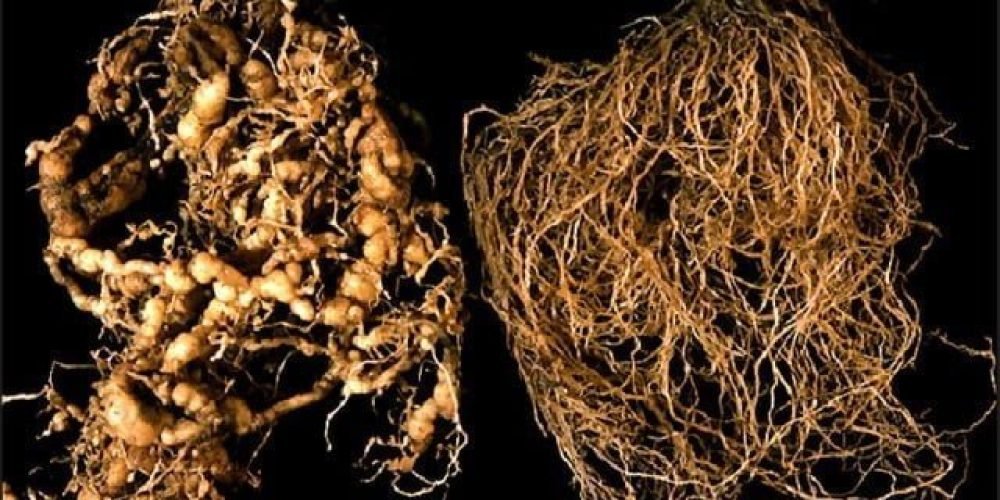Cucumber diseases
Disease name: Root knot nematode
The scientific name: Root Knot Nematode
Disease family: It infects crops of the cucurbit family, eggplant, and most field crop plants.
Symptoms of the diseaseStunting in plant growth, yellowing and wilting of leaves during the hot daylight hours is observed. Plants rarely die early due to infection. It is noted that nodules appear on the infected roots, which are swellings resulting from an increase in cells and an increase in the rate of cell division. The nodules hinder the absorption of water and salts in sufficient quantities and contain the different stages of worms. The caecilian causes knotting, and root nodules may not form in the case of infestation of corn, asparagus, and onion crops, as the female is flattened in shape and resembles a pear. General weakness and death of some plants is also observed, which follows yellowing as a result of damage to the roots and their decomposition. It is also noted that the root system is reduced and the thin root hairs are not formed.
The causes of disease: The disease is caused by the caecilian worm, which causes root knot disease. It is of the genus Meloidogyne and exists in several species, perhaps numbering 70 species.
Conditions suitable for the spread of the diseaseRoot knot nematode disease spreads in moist, warm environments. The appropriate temperature for the different stages to develop ranges from 27-30 degrees Celsius. It may produce three to five generations during the season, and each generation needs 30 days depending on soil moisture and air temperature. Nematode numbers decrease when the temperature falls below 15 degrees Celsius or exceeds 33 degrees Celsius, and soil moisture is necessary for egg hatching and larval movement.
Disease development cycle: They reproduce in the presence of the male or without him, meaning that it can be self-pollinated, and when the eggs hatch, the second stage of the larva emerges, which is the infectious stage that swims in the soil to attack the roots, and inside the root tissue, the second molt occurs, resulting in the third instar of the larva. Then several molts occur, resulting in the juvenile stage, i.e. the male and female. Pollination occurs when the female becomes ready to lay eggs. She turns her back towards the surface of the root to place the eggs in the gelatinous sac. One female lays hundreds of eggs, after which the male leaves the root. The different stages may remain inside the root, resulting in knots and swellings. The life cycle is affected by climatic factors and is the source of infection in successive seasons. From eggs found in the remains of infected plants from the past season or in the soil. The infection can also be transmitted through seedlings and parts of infected imported plants.
Losses from the spread of disease: It causes significant economic losses as a result of damage to the roots, which lose their function due to the growth of different stages of worms inside the root tissue.
Control strategy: Using an Integrated Pest Management (IPM) approach, which involves using different control methods to control the spread of nematodes and effectively avoid the risks of infection associated with fungi or bacteria. By focusing on nematode control, we can protect our crops from complex diseases and promote sustainable agricultural practices.
Preventive measures to prevent the occurrence of the disease: Treat the infected land with the recommended nematicide before planting, or when the infection is discovered, treatment is carried out immediately. In some crops, the treatment is 3 days before planting if it is known that the land is infested with nematodes, or 3-7 days after planting, and the treatment can also be done 30 days after planting.
Organic and chemical control recommendations:
- Treat the seedlings with warm water at a temperature of 50°C for ten minutes to kill the contaminated larvae. They can also be treated with chemical disinfectants to prevent the infection from spreading to uncontaminated land.
- Treating the soil with heat or chemical fumigants in order to eliminate the source of infection, which is the eggs present in the soil. Summer tillage also helps reduce nematode numbers.
- Planting resistant varieties and planting plant traps, such as marigolds, which caterpillars can infect but do not allow them to grow or reproduce. Among the resistant varieties are Marmande, Roforto.
- Follow an agricultural rotation that includes crops that do not become infected with the disease, such as oats or wheat, to reduce the number of worms in the soil.
- Adding organic matter to the soil to encourage microbes that compete with root-knot nematodes.
- Raking and getting rid of weeds.
- Use biological control with the fungus Endomycorrhizae, Glamus or Trichoderma, the bacteria Pasteuria Penetrans, or the fungus Paecilomyes Lilacinus.



